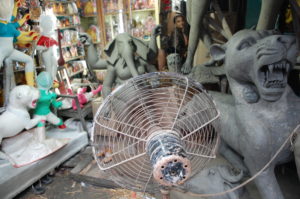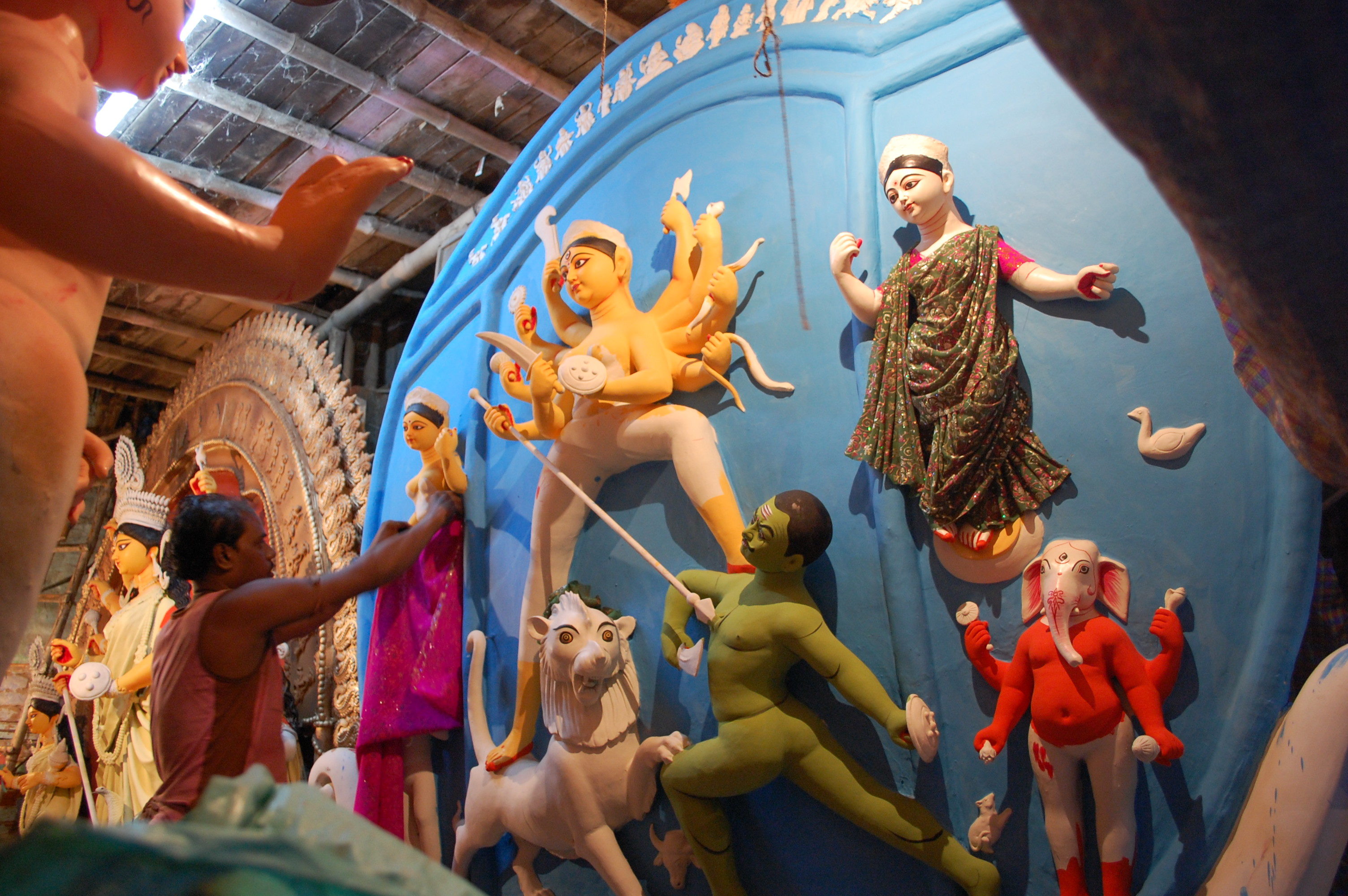It is that time of the year. Durga Pujo is just a week away. It starts as soon as the Devi Paksha starts, mind you, in downtown Kolkata. The moment the state Chief Minister starts visiting the makeshift pujo premises installed in every possible nook and corner of the city, the pujo fervor sets in. In spite of major hiccups like the flyover collapse in Majherhat and minor anxieties like the promised ‘transplant’ of the Andaman and Nicobar Islands within a compound that will hardly fit a standard badminton court, this year’s pujo is poised to roll.
The weather god has been erratic this autumn. The rain clouds seem to have vanished, giving room to a sultry weather that smells of high summer. Had it been any other year, all the eyes would have been trained on the narrow lanes and bylanes along Banamali Sarkar Lane, better known as Kumartuli. This is the largest conglomeration of clay image makers known in this part of the world. At present, the area falls within Ward No. 9 of Kolkata Municipal Corporation.
Previously spelt ‘Coomartolly’, this colony of image makers dates back to the early days of urbanization in Calcutta. In an early attempt to plan the new town according to the needs of the dwellers and the professions, the British town planners designated this area for the potters who made household utensils with clay acquired from the river. Mostly potters, the artisans had a ready market in Hatkhola that later on extended to the area now known as Burrabazar. They also sculpted deities, occasionally. When Durga Pujo started happening in the late 18th century, and more and more Bengali families started emulating the autumnal ritual, they began to sculpt clay images of the mother goddess. The inspiration came straight from the Krishnanagar derivative that held sway thanks to the patronage of the Debs of Sovabazar. Till the first decades of the 20th century, the image makers of Kumartuli supplied idols to the houses. With the coming of the community pujo in the 1910s, and the mushrooming of this trend in the post-1947 era, Kumartuli began to develop as a clay image hub, overtaking the primacy of Ghurni in Krishnanagar.
The Partition of Bengal transformed the composition of Kumartuli. As scores of traditional potters, the Pals and the Rudrapals in particular, settled in various parts of West Bengal, the earliest and the best settled in Kumartuli. Mostly hailing from the Bikrampur region in Dhaka division, these potters brought in new aesthetics and work ethics that superseded the practices upheld over one and a half century. The ekchala pratima that combined the holy family, their pets and the demon in one tight semi-circular composition backed by a painted backdrop gradually gave way to the panch putul comprising of separate idols standing on their own, having separate backdrops. The faces began to evolve. The ornaments, and the attires began to change. Daker saj and Sholar saj that gained legendary repute started finding stiff competition from the jari works that started arriving from Surat. Some artisans began to combine them, winning new admirers. Bagbazar Sarbajanin that enjoyed the patronage of Subhash Chandra Bose among many others of his ilk set the standards for a traditional ekchala pratima. College Square Sarbajanin, followed by Mohammad Ali Park Sarbajanin hailed the new order.
Most importantly, the divine family started looking more human than ever. With Ramesh Chandra Pal as the image maker, the College Square idol, followed by the Park Circus Beniapukur one, looked distinctly Bengali. When Alok Sen, a sculptor trained at the Art College, designed the Mohammad Ali Square idol in the early 1970s, political undercurrents began to show up. Since then, image makers started referring to contemporary events in their works, sometimes alluding to natural disasters as well.

With the new millennium setting in, a whole new era of thematically grounded Durga pujo started calling the shots. As the idol became merely an ornament in the new aesthetic order governed by mercantile interests, the Kumartuli artisans began to lose the ground that they had held for so long. Although many north Kolkata pujos and some of the south Kolkata brethren still refuse to do away with the ‘tradition’ they are identified with, the newer ones with no tradition to adhere to started experimenting. Initially the fad for materials worked wonders, drawing hundreds and thousands to appreciate the pandal made of sugar cane fibre or decorated with gramophone records. There were many more bizarre ideas to choose from. Nowadays, the designer who may or may not be an image maker rules the idol market. Bakulbagan in the Bhowanipore area started experimenting with the painters and sculptors in the 1970s. Many more have joined the fray. Painters like Sanatan Dinda have recently sculpted idols, drawing multitudes to places like the narrow Nalin Sarkar Street off Maniktala crossing.
Amidst all this hue and cry, the primacy of Kumartuli image makers has diminished. Yet new generation of image makers have joined the family trade. Thousands of idols are made in Kumartuli every year. A handful is flown to distant shores where the non-resident Bengalis make merry with the idol at the centre. With Mahalaya here, the activity has reached a feverish high. Bookings are almost over. It has been a little relaxing this year. The polythene sheets were not needed at all. The burner lamps were not pressed into action. The area will breathe easy from the mid of October when last of the idols find a taker.
There are problems though. Some are pretty nagging. Nowadays, it is not easy to get seasonal workers to assist the image makers. Apparently the fissure in agrarian Bengal is showing. As new faces are missing, the seasoned ones are asking for 20-25 thousand for a two-month contract. The material prices are skyrocketing each year. Regulations about colours have trebled the prices. But the pujo organizers are not ready to hike the rates. The soil collected from the Ganga is getting worse every year, causing skin diseases. Today, the image makers use two types of clay. The fairer one is collected straight from the Ganga. It has a larger proportion of sand. The darker variety is imported from areas as far as Diamond Harbour or Budge Budge. The haystacks come from Uluberia. All the prices are soaring. And there is no one pay heed.
Kumartuli is bleeding, the insiders would tell you. Inspite of a masterplan that took a decade to be completed, a holistic development of this area is yet to start. Occasional visits to the area during the days preceding the Pujo will reveal little of the inhuman living conditions that the artisans embrace as their fate. The hordes of photographers who make it a point to direct the newly purchased lenses at the semi-finished idols and shoot, never caring about the privacy of the artisans at work, have made their lives a misery. There had been efforts to control this menace, with little results. Therefore, the artisans, extraordinarily patient and cool in city standards, have resigned to their fate.
With another era of idol workship setting in, and Ganesha and Hanuman finding more takers than ever, there is a silver lining that keeps Kumartuli optimistic at this point of time.
[Photographs by Anshuman Bhowmick]


Comments are closed.